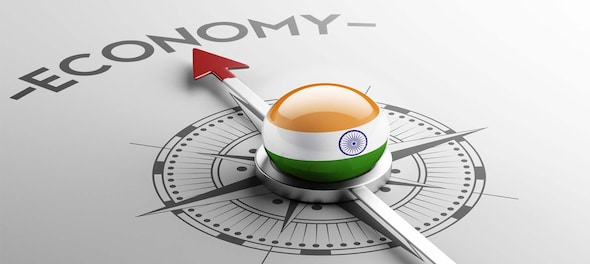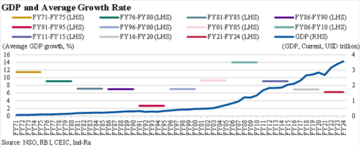
India, recognised as the fastest-growing economy among G20 developing nations, is setting its sights on transitioning into a developed economy by 2047. According to India Ratings and Research (Ind-Ra), the current estimated GDP of $3.6 trillion in FY24 could pave the way for India to enter the upper-middle income category (per capita income $4,466-13,845) between FY33 and FY36, reaching a milestone of a $15-trillion economy by FY47.
Ind-Ra has, however, set an ambitious estimate of the country becoming a $30-trillion economy by 2047, dependent on certain factors.
Dr Sunil Kumar Sinha, Senior Director and Principal Economist at Ind-Ra, emphasised the pivotal role of real GDP growth, inflation (GDP deflator), and the INR/USD exchange rate in shaping India's economic trajectory.
“The onward journey of Indian economy from India Ratings and Research (Ind-Ra) estimated USD3.6 trillion dollars in FY24 will depend on the rate at which the real GDP growth, inflation (GDP deflator) and INR/USD exchange rate evolve,” Sinha said.
“We expect the Indian economy under different scenarios to enter into the upper-middle income category (per capita income USD4,466-13,845) over FY33–FY36 and to a USD15 trillion economy over FY43-FY47,” Sinha added.
Until 2006, the World Bank classified India as a low-income country. In 2007, India moved to the lower-middle income country and since then has remained there. India’s per capita GDP stood at $2,390 in 2022, the report stated.
Ind-Ra's ambitious estimate of reaching $30 trillion by FY47 requires a substantial annual growth rate of 9.7% in current USD terms from FY24 to FY47. Historical data over the past 50 years highlights that sustaining such a high growth rate for a decade is rare, with only two instances in 1973-1982 and 2003-2012.
While India exhibits robust economic growth, global trade challenges and protectionist measures adopted by developed economies since FY12 pose potential obstacles. The shift towards trade fragmentation and climate-related policy changes further complicates India's journey towards the $30-trillion target by 2047.

Despite uncertainties surrounding the $30-trillion target, Ind-Ra's estimates suggest that India's per capita income could range from $9,218 to $9,920 between FY43 and FY47. This projection places India in proximity to the high-income country threshold of $13,846 per capita.
Beyond economic indicators, Ind-Ra identifies key factors influencing India's economic trajectory, including energy transition, low carbon manufacturing/services, and the expansion of the middle class. India's commitment to energy transition, showcased at the COP26 Summit, positions it as a major player in renewable energy, with ambitious targets such as 500GW renewable energy capacity by 2030 and achieving a net-zero economy by 2070.
The focus on low-carbon products and services, as exemplified by India's first green hydrogen plant-based stainless steel manufacturing facility commissioned in March 2023, is expected to contribute significantly to India's growth.
Additionally, the rising incomes and aspirational lifestyle of the middle-income class are identified as key drivers of demand for goods and services. According to People Research on India's Consumer Economy, the middle-class population is projected to grow substantially, reaching 715 million in 2030-31 and 1.02 billion in 2046-47.
Ind-Ra has, however, set an ambitious estimate of the country becoming a $30-trillion economy by 2047, dependent on certain factors.
Dr Sunil Kumar Sinha, Senior Director and Principal Economist at Ind-Ra, emphasised the pivotal role of real GDP growth, inflation (GDP deflator), and the INR/USD exchange rate in shaping India's economic trajectory.
“The onward journey of Indian economy from India Ratings and Research (Ind-Ra) estimated USD3.6 trillion dollars in FY24 will depend on the rate at which the real GDP growth, inflation (GDP deflator) and INR/USD exchange rate evolve,” Sinha said.
“We expect the Indian economy under different scenarios to enter into the upper-middle income category (per capita income USD4,466-13,845) over FY33–FY36 and to a USD15 trillion economy over FY43-FY47,” Sinha added.
Until 2006, the World Bank classified India as a low-income country. In 2007, India moved to the lower-middle income country and since then has remained there. India’s per capita GDP stood at $2,390 in 2022, the report stated.
| Size of Indian Economy and Per Capita Income Under Various Scenarios | ||||
| GDP, Nominal | Scenario A (per annum Real GDP growth:6.25%, GDP deflator growth 3.50% and INR/USD depreciation 3.25%) | Scenario B (per annum Real GDP growth:7.0%, GDP deflator growth 3.5% and INR/USD depreciation 3.5%) | Scenario C (per annum Real GDP growth:7.0%, GDP deflator growth 3.5% and INR/USD depreciation 4.0%) | Scenario D (per annum Real GDP growth:8.0%, GDP deflator growth 3.5% and INR/USD depreciation 3.25%) |
| USD5 trillion | FY30 (3,467) | FY29 (3,358) | FY30 (3,463) | FY29 (3,530) |
| USD10 trillion | FY41 (6,471) | FY40 (6,574) | FY41 (6,449) | FY37 (6,354) |
| USD15 trillion | FY47 (9,218) | FY46 (9,613) | FY47 (9,175) | FY43 (9,920) |
| Note: Numbers in parenthesis are per capita income in USD in the fiscal year mentioned. Source: United Nations Population Division, Ind-Ra | ||||
Ind-Ra's ambitious estimate of reaching $30 trillion by FY47 requires a substantial annual growth rate of 9.7% in current USD terms from FY24 to FY47. Historical data over the past 50 years highlights that sustaining such a high growth rate for a decade is rare, with only two instances in 1973-1982 and 2003-2012.
While India exhibits robust economic growth, global trade challenges and protectionist measures adopted by developed economies since FY12 pose potential obstacles. The shift towards trade fragmentation and climate-related policy changes further complicates India's journey towards the $30-trillion target by 2047.

Despite uncertainties surrounding the $30-trillion target, Ind-Ra's estimates suggest that India's per capita income could range from $9,218 to $9,920 between FY43 and FY47. This projection places India in proximity to the high-income country threshold of $13,846 per capita.
Beyond economic indicators, Ind-Ra identifies key factors influencing India's economic trajectory, including energy transition, low carbon manufacturing/services, and the expansion of the middle class. India's commitment to energy transition, showcased at the COP26 Summit, positions it as a major player in renewable energy, with ambitious targets such as 500GW renewable energy capacity by 2030 and achieving a net-zero economy by 2070.
The focus on low-carbon products and services, as exemplified by India's first green hydrogen plant-based stainless steel manufacturing facility commissioned in March 2023, is expected to contribute significantly to India's growth.
Additionally, the rising incomes and aspirational lifestyle of the middle-income class are identified as key drivers of demand for goods and services. According to People Research on India's Consumer Economy, the middle-class population is projected to grow substantially, reaching 715 million in 2030-31 and 1.02 billion in 2046-47.
Check out our in-depth Market Coverage, Business News & get real-time Stock Market Updates on CNBC-TV18. Also, Watch our channels CNBC-TV18, CNBC Awaaz and CNBC Bajar Live on-the-go!
